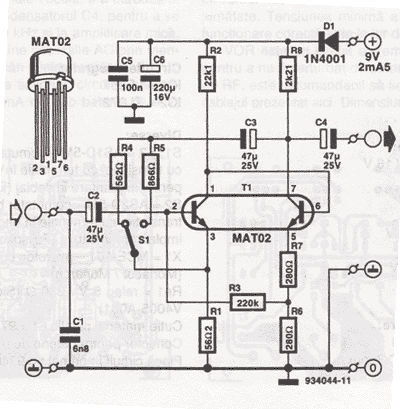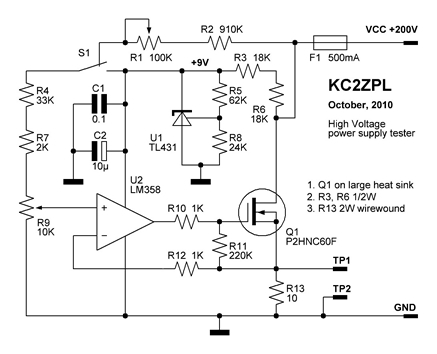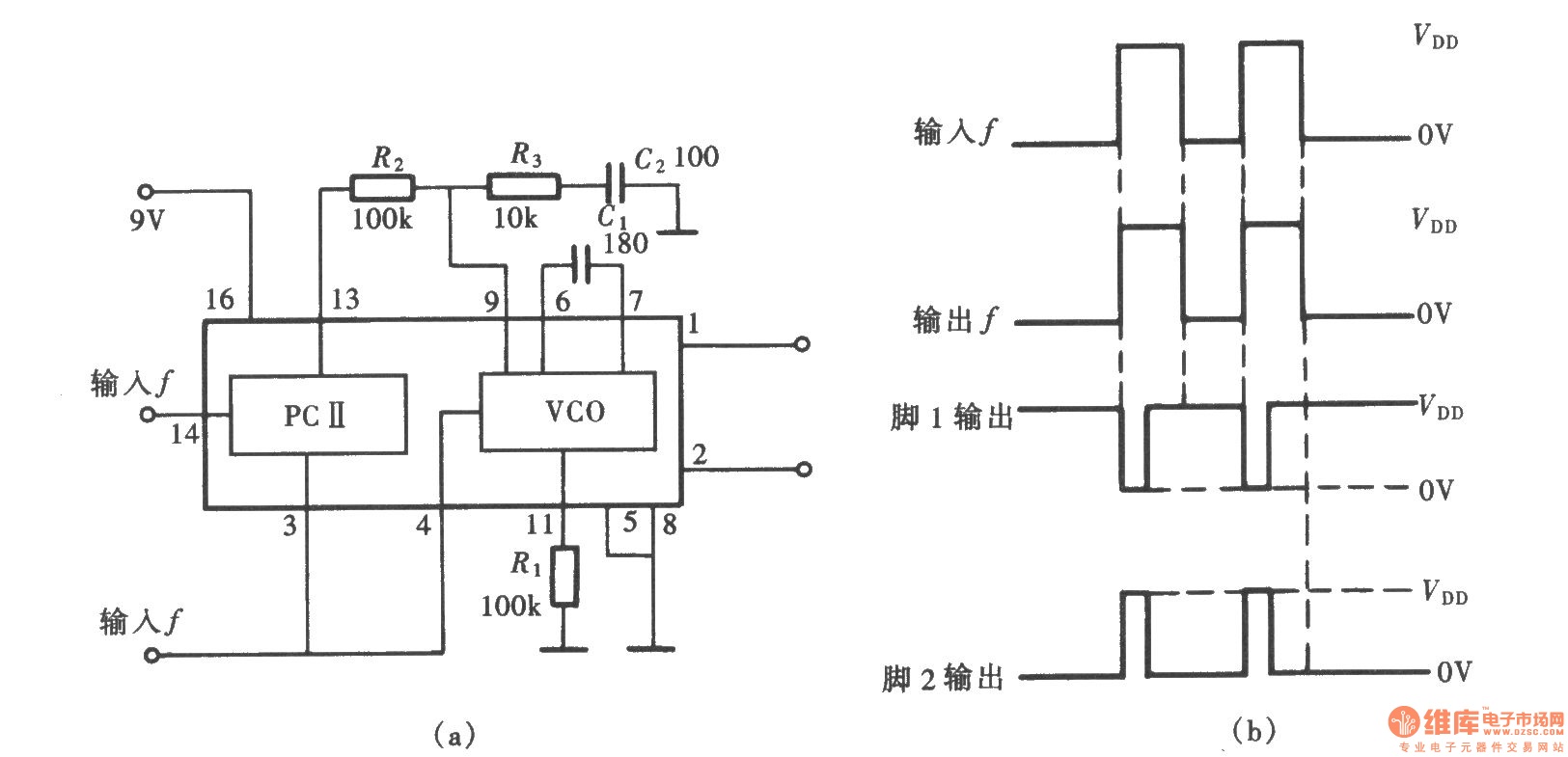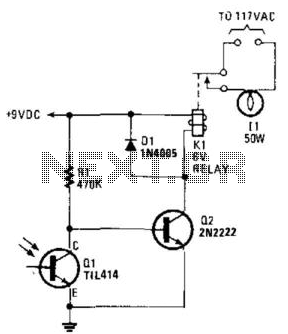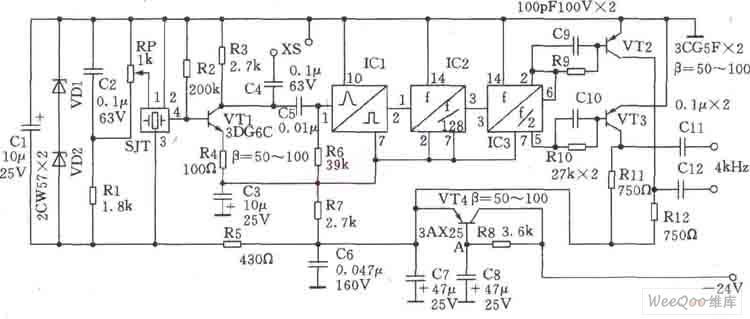
Electronic rodent control circuit
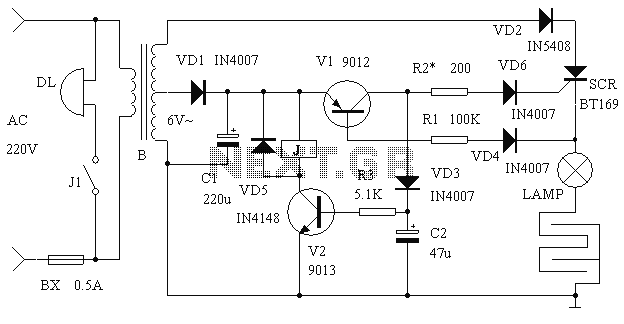
It is said that mice are more sensitive to electromagnetic fields, which is why high-voltage grids generally yield poor results in rodent control. The electronic rodent control system described here does not use high-voltage power lines, thus it does not alert the mice. However, when a mouse triggers the power grid, the high-voltage grid can instantly kill it, making this method more effective. The working principle of the circuit is shown in the figure. Component B is an isolated step-up transformer. The use of the ground as a grid electrode prevents the malfunction of mains security devices. The transformer circuit is isolated from the mains. The secondary low voltage of about 6V is rectified by VD1, and C1 filters the DC voltage to obtain approximately 7V for control. High voltage alternating current is derived from a pulsating rectified voltage through VD2, which powers the tagging mechanism. A thyristor (SCR) is used for high on/off control; the SCR's cathode is connected to the power line through a lamp. In a static state, the base circuit of transistor V1 is suspended and turned off, which also turns off the SCR, reducing the power grid to a low DC voltage. This generates a weak electric field, preventing the mice from raising an alarm. When a rat crosses the grid, V1 immediately triggers the SCR, applying high-pressure pulsation to the lamp and killing the mouse. Simultaneously, V2 becomes saturated and conducts, activating relay J, which powers an electric bell (DL) to alert staff to promptly remove the dead rats. The component selection and production list includes: R1 (100K resistor), R2 (adjustable 200 ohm resistor), R3 (5.1K resistor), C1 (220u electrolytic capacitor), C2 (47u electrolytic capacitor), VD1,3,4,6 (IN4007 diodes), VD2 (IN5408 rectifier diode), VD5 (IN4148 switching diode), V1 (9012 transistor), V2 (9013 transistor), SCR (BT169), J (6V small relay), BX (0.5A fuse), B (step-up transformer), and LAMP (60W incandescent bulb). The transformer is restructured to about 300W by removing the low-voltage winding and winding approximately 1200 turns of 0.25mm enameled wire, with a tap at 13 turns for the low-voltage winding. The 6V small relay J is used. All components are mounted on a circuit board. A wire grid is placed on the ground, elevated by porcelain insulation supports, forming a channel with common circuit nails driven into the ground. To enhance the effect, some water can be splashed on the ground.
The electronic rodent control circuit operates by utilizing a combination of low and high voltage components to create a safe yet effective means of exterminating rodents. The isolated step-up transformer (B) is critical for elevating the voltage while ensuring safety from mains interference. The design ensures that the primary circuit remains isolated, preventing any accidental activation of the mains power, which could lead to hazardous situations.
The circuit begins with the low voltage side, where the transformer generates approximately 6V. This voltage is rectified by diode VD1 and smoothed by capacitor C1, providing a stable DC voltage of about 7V for the control circuitry. The control mechanism is activated by the presence of a rodent. When a mouse crosses the grid, the presence is detected by the transistor V1, which switches the SCR into conduction mode, allowing high voltage to flow through the circuit momentarily. This high voltage is then applied to the lamp, which serves as a visual indicator while simultaneously delivering a lethal shock to the rodent.
The relay J is employed for alerting personnel, ensuring that the system is not only effective in exterminating rodents but also in maintaining operational awareness. The inclusion of an electric bell (DL) provides an auditory signal, prompting immediate action to remove the deceased rodents.
The careful selection of components, such as the specific types of resistors, capacitors, and semiconductors, is vital for the reliability and efficiency of the circuit. Each component plays a specific role, from voltage regulation to signal processing, ensuring the circuit operates as intended under various conditions. The overall design is a practical application of electronic principles to solve a common pest control problem, while also considering safety and functionality.It is said that the mice are more sensitive to electromagnetic fields, which is why the high-voltage grid rodent generally poor results. Electronic rodent control described here, no high-voltage power line usually, it does not cause mouse alert,
but as long as the body of a mouse trigger power grid, high-voltage power grid will immediately be able to instantly kill him, the rodent is better. working principle Circuit shown in Figure, B is an isolated step-up transformer. Due to the use of land as a grid electrode to prevent Warfarin mains security devices malfunction, the transformer circuit and mains isolation.
Secondary low pressure by about 6V VD1 rectifier, C1 filtering DC voltage of about 7V obtained for control. High voltage alternating current by a pulsating rectified voltage VD2 obtained power for tag. Way thyristor SCR for a high on / off control, SCR cathode connected to the power line by LAMP. Static, due to the base circuit of the transistor V1 suspension and off, SCR is also turned off the power grid to be only between a low DC voltage, thereby generating an electric field is weak, so that the mouse will not raise the alarm.
When a rat across the grid, V1 immediately turned the SCR triggered by high pressure pulsation LAMP immediately applied power line, the mice were killed. At the same time, V2 is saturated conduction, the relay J pull power, electric bell DL power and started to inform staff will promptly remove dead rats.
Component selection and production Component list is as follows Number Name Type Quantity R1 resistor 100K 1 R2 * 200 resistor to be adjusted 1 R3 resistance 5.1K 1 C1 electrolytic capacitors 220u 1 C2 electrolytic capacitors 47u 1 VD1,3,4,6 IN4007 4 VD2 rectifier diode rectifier diode IN5408 1 VD5 switching diode IN4148 1 V1 transistor 9012 1 V2 transistor 9013 1 SCR way SCR BT169 1 J relay 6V small 1 BX fuse 0.5A µ0.5cm 2cm 1 B transformer restructuring, 1 LAMP incandescent 60W / 220V 1 B selection control transformer 300W about restructuring, the low voltage winding removal, another with µ0.25mm enameled wire around 1200 turns, tapped at 13 turns for the low-voltage winding. J 6V with a small relay. The production of all components mounted on a circuit board. Available wire grid on the ground 2cm high number of porcelain insulation supporting wound channel is formed with a common circuit nails driven into the ground.
To enhance the effect, you can splash some water on the ground.
The electronic rodent control circuit operates by utilizing a combination of low and high voltage components to create a safe yet effective means of exterminating rodents. The isolated step-up transformer (B) is critical for elevating the voltage while ensuring safety from mains interference. The design ensures that the primary circuit remains isolated, preventing any accidental activation of the mains power, which could lead to hazardous situations.
The circuit begins with the low voltage side, where the transformer generates approximately 6V. This voltage is rectified by diode VD1 and smoothed by capacitor C1, providing a stable DC voltage of about 7V for the control circuitry. The control mechanism is activated by the presence of a rodent. When a mouse crosses the grid, the presence is detected by the transistor V1, which switches the SCR into conduction mode, allowing high voltage to flow through the circuit momentarily. This high voltage is then applied to the lamp, which serves as a visual indicator while simultaneously delivering a lethal shock to the rodent.
The relay J is employed for alerting personnel, ensuring that the system is not only effective in exterminating rodents but also in maintaining operational awareness. The inclusion of an electric bell (DL) provides an auditory signal, prompting immediate action to remove the deceased rodents.
The careful selection of components, such as the specific types of resistors, capacitors, and semiconductors, is vital for the reliability and efficiency of the circuit. Each component plays a specific role, from voltage regulation to signal processing, ensuring the circuit operates as intended under various conditions. The overall design is a practical application of electronic principles to solve a common pest control problem, while also considering safety and functionality.It is said that the mice are more sensitive to electromagnetic fields, which is why the high-voltage grid rodent generally poor results. Electronic rodent control described here, no high-voltage power line usually, it does not cause mouse alert,
but as long as the body of a mouse trigger power grid, high-voltage power grid will immediately be able to instantly kill him, the rodent is better. working principle Circuit shown in Figure, B is an isolated step-up transformer. Due to the use of land as a grid electrode to prevent Warfarin mains security devices malfunction, the transformer circuit and mains isolation.
Secondary low pressure by about 6V VD1 rectifier, C1 filtering DC voltage of about 7V obtained for control. High voltage alternating current by a pulsating rectified voltage VD2 obtained power for tag. Way thyristor SCR for a high on / off control, SCR cathode connected to the power line by LAMP. Static, due to the base circuit of the transistor V1 suspension and off, SCR is also turned off the power grid to be only between a low DC voltage, thereby generating an electric field is weak, so that the mouse will not raise the alarm.
When a rat across the grid, V1 immediately turned the SCR triggered by high pressure pulsation LAMP immediately applied power line, the mice were killed. At the same time, V2 is saturated conduction, the relay J pull power, electric bell DL power and started to inform staff will promptly remove dead rats.
Component selection and production Component list is as follows Number Name Type Quantity R1 resistor 100K 1 R2 * 200 resistor to be adjusted 1 R3 resistance 5.1K 1 C1 electrolytic capacitors 220u 1 C2 electrolytic capacitors 47u 1 VD1,3,4,6 IN4007 4 VD2 rectifier diode rectifier diode IN5408 1 VD5 switching diode IN4148 1 V1 transistor 9012 1 V2 transistor 9013 1 SCR way SCR BT169 1 J relay 6V small 1 BX fuse 0.5A µ0.5cm 2cm 1 B transformer restructuring, 1 LAMP incandescent 60W / 220V 1 B selection control transformer 300W about restructuring, the low voltage winding removal, another with µ0.25mm enameled wire around 1200 turns, tapped at 13 turns for the low-voltage winding. J 6V with a small relay. The production of all components mounted on a circuit board. Available wire grid on the ground 2cm high number of porcelain insulation supporting wound channel is formed with a common circuit nails driven into the ground.
To enhance the effect, you can splash some water on the ground.
Warning: include(partials/cookie-banner.php): Failed to open stream: Permission denied in /var/www/html/nextgr/view-circuit.php on line 713
Warning: include(): Failed opening 'partials/cookie-banner.php' for inclusion (include_path='.:/usr/share/php') in /var/www/html/nextgr/view-circuit.php on line 713
